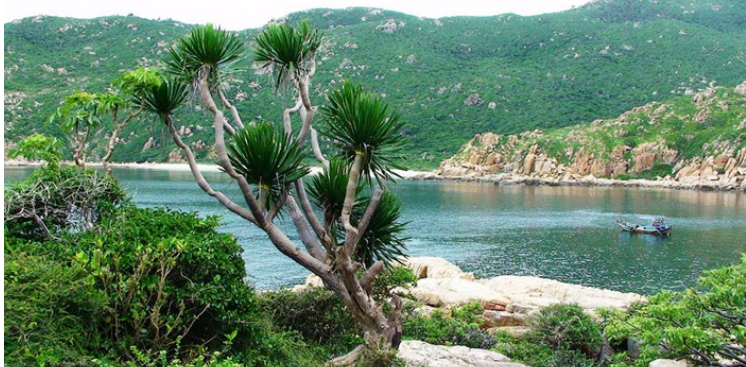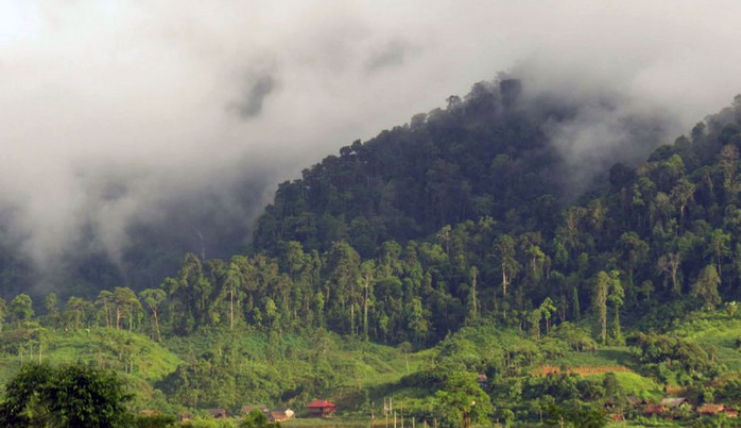
Relatively intact evergreen broadleaf forest system – source: https://luhanhvietnam.com.vn/
Na Hau Nature Reserve with a total natural area of 16,950 hectares, located in 4 communes of Na Hau, Dai Son, Mo Vang and Phong Du Thuong (Van Yen district, Yen Bai province), has a rich and diverse natural forest ecosystem typical of the northern mountainous region of Vietnam with many rare species of animals and plants. This is also considered an ideal eco-tourism destination for those who love nature, love adventure and want to learn and explore the traditional culture of the Mong people in Na Hau commune.
Na Hau Nature Reserve of Van Yen district is known as a place that preserves a rich and diverse ecosystem of flora and fauna. From the center of Mau A town, Van Yen district, crossing Mau A bridge over the Red River along the route from An Thinh commune to Dai Son commune about 30 km to the Southwest, passing Ba Khuy slope across the mountainside, visitors will reach Na Hau commune, a commune where 100% of Mong people live.
Coming to Na Hau, all the noise of the city seems to be left behind. The beauty of the ancient forests is solemn, bringing a strange attraction to visitors. The primeval forest canopy gives the Reserve a truly fresh, pure atmosphere and brings people closer to nature than ever. Located at an average altitude of 600 – 700 m above sea level, the highest point is 1,800 m, the lowest point is 200 m, so the terrain of Na Hau is strongly divided, forming many streams and many beautiful caves and waterfalls such as Ban Tat waterfall, Suoi Tien waterfall, Bat cave…
Na Hau area is like a basin formed from a narrow valley, surrounded by high mountains. The terrain here is strongly divided, creating many streams and water confluences. The average altitude is from 600 – 700m above sea level, the highest place is 1,788m, the lowest place is 200m. The average temperature is 23.2 degrees Celsius, the average rainfall is 1,458.0 mm/year, humidity is 85%. Every year, the Northeast monsoon often appears in November and December with frost. On less sunny days, the sky is cloudy, in high mountainous areas, fog covers all day, the humidity in the forest is very high. With such climatic conditions, it is very suitable for the growth and development and natural regeneration of forest trees, favorable for the diverse and rich development of flora and fauna here, creating a dense forest structure with many canopy layers suitable for the protection of the headwaters.
In this nature reserve, the evergreen broadleaf forest system is still relatively intact, with many streams, streams, and waterfalls flowing all year round. The forest structure has not been broken, the canopy is clearly divided: The highest layer is large trees that protrude intermittently, mainly species such as brown acacia, doi, tram, etc.; the middle layer is the ecologically dominant layer, the canopy of the forest is continuously almost the same height, belonging to evergreen species such as goi, de, be…; the lower layer is divided into many layers of different heights, mainly small shade-loving trees; the fresh carpet layer is mainly shrubs, ferns, wild areca, etc.; Currently, the natural forest still has over 30 different plant species, including rare species of trees such as lat hoa, po mu, etc., growing mainly at an altitude of 700m or higher.

Na Hau has a terrain like a basin created from a narrow valley – source: https://luhanhvietnam.com.vn/
The fauna in the reserve is quite rich and many rare species are still preserved and conserved. Currently, the forest has about 72 species of animals, 240 species of birds, 48 species of reptiles…, including many valuable species listed in the Vietnam Red Book and the World Red List such as mountain goats, bears, black gibbons, gray langurs, big-headed turtles, and flower monitors. In addition, the forest area in the core zone of the Nature Reserve is also home to a number of bird species with narrow distribution areas, including a number of globally threatened bird species such as hornbills, pheasants…
In addition, when exploring Na Hau Nature Reserve, visitors can also immerse themselves in the Suoi Tien waterfall hidden in the primeval forest of village 2 (Khe Tat). On the way to the waterfall, visitors must overcome large rocks and ancient trees. Suoi Tien waterfall is quite long and has 3 floors, each floor is also relatively high. The clear, cool water source from the top of the mountain pours down, creating white foam all year round. On summer days, Suoi Tien waterfall always attracts a lot of tourists to come here to immerse themselves in the cool, clear water and feel the melodious melodies raised by the sound of the waterfall, the mountain wind and the chirping of birds in a truly peaceful space. Not only attracting tourists by the wild, lyrical natural scenery, the people here are mainly Mong and Dao ethnic groups with unique ethnic cultural beauty such as customs, costumes, housing, and cuisine. Coming here, visitors will be immersed in the New Year festival of the forest, the Khen dance, the money stick dance of the Mong people, and enjoy rustic dishes imbued with national identity prepared by the skillful hands of the simple and hospitable Mong people.
With its available natural potential, Na Hau nature reserve has all the favorable factors, suitable for developing current types of tourism such as: eco-tourism, adventure tourism, community tourism… In the future, Na Hau will be an attractive destination for domestic and foreign tourists.
Source: Department of Natural Resources and Environment



